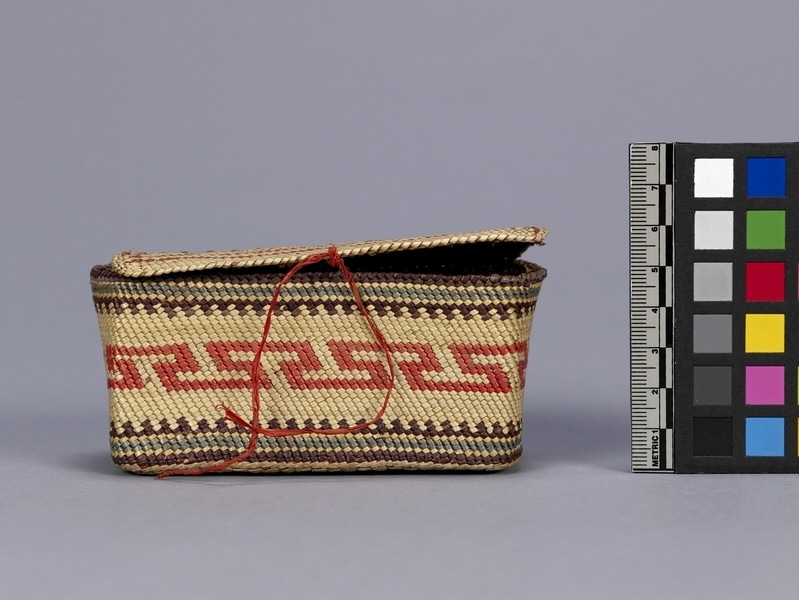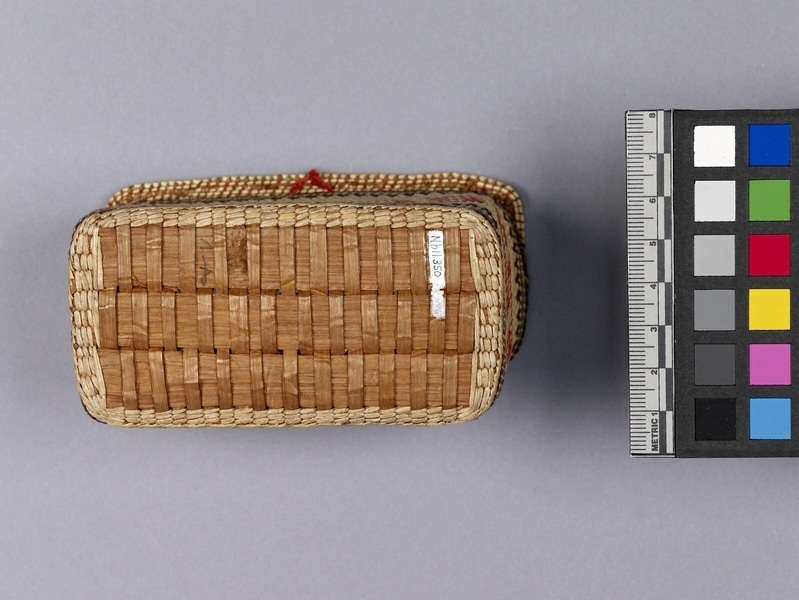Basket Item Number: Nb11.350 from the MOA: University of British Columbia



Description
Rectangular woven basket with an attached flap-like lid. At front edge of flat lid is red grass tie. At the rim of basket the ends have bowed out leaving a gap between edge of rim and lid at each end of the basket. Bottom of basket consists of three wide strips of cedar bark weft plaited with thin strips of cedar bark warp. Natural colour with three equidistant bands of geometric designs. At mid-point of basket is large scale red geometric design. Lid has horizontal red stripes. Mid-point of flat lid has wide blue-purple strip held in place by cedar bark warps. Edges of basket finished by twining and twill twining.
History Of Use
Before European contact Nuu-chah-nulth baskets were predominately undecorated, all-purpose containers. Checkerwork bags and pouches were used for whaling and fishing gear. Finely woven baskets held liquids and were used to boil food by adding heated stones. By the mid-19th century, when missions and trading posts were well established on the Northwest Coast, the manufacture of functional basketry declined and the Nuu-chah-nulth began to make small decorated 'fancy' baskets for sale. These baskets are characterized by realistic and less frequently, geometric designs. Up to the 1890's Nuu-chah-nulth basketry is open wrapped twined, checkerwork and plain twilled. After this date most are close wrapped twined.
Cultural Context
made for sale
Item History
- Made in Vancouver Island, British Columbia, Canada before 1976
- Collected during 1900
- Owned by Dorothy Ladner and Edna Ladner before April 12, 1976
- Received from Dorothy Ladner (Donor) and Edna Ladner (Donor) on April 12, 1976
What
- Name
- Basket
- Identification Number
- Nb11.350
- Type of Item
- basket
- Material
- bear grass ?, grass, cedar bark and aniline dye ?
- Manufacturing Technique
- wrapped twined, twill twined and twined
- Overall
- height 5.5 cm, width 11.5 cm, depth 5.5 cm
Who
- Culture
- Nuu-chah-nulth
- Previous Owner
- Dorothy Ladner and Edna Ladner
- Received from
- Dorothy Ladner (Donor) and Edna Ladner (Donor)
Where
- Holding Institution
- MOA: University of British Columbia
- Made in
- Vancouver Island, British Columbia, Canada
When
- Creation Date
- before 1976
- Collection Date
- during 1900
- Ownership Date
- before April 12, 1976
- Acquisition Date
- on April 12, 1976
Other
- Item Classes
- basketry
- Condition
- good
- Current Location
- Case 9
- Accession Number
- 0299/0034